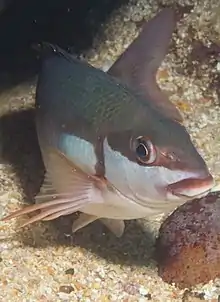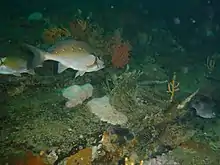| Chirodactylus brachydactylus | |
|---|---|
 | |
| Scientific classification | |
| Domain: | Eukaryota |
| Kingdom: | Animalia |
| Phylum: | Chordata |
| Class: | Actinopterygii |
| Order: | Perciformes |
| Family: | Cheilodactylidae |
| Genus: | Chirodactylus |
| Species: | C. brachydactylus |
| Binomial name | |
| Chirodactylus brachydactylus (Cuvier, 1830) | |

Chirodactylus brachydactylus, the twotone fingerfin, is a species of marine fish in the fingerfin (morwongs) family (family Cheilodactylidae) of order Perciformes. It is native to the coast of southern Africa.[1][2]
Distribution
Along the coast of southern Africa from Walvis Bay to Maputo.[1] Subtropical, between 23°S and 36°S in eastern Atlantic and western Indian oceans.[3]
Description
Body colour basically brown, paler on ventral side, with a brighter white area below the eyes in the front part of the body, and a row of five white spots along the lateral line. Juveniles are silvery with orange anal and paired fins. Colour changes to adult colouration from about 5 cm. The fish has fleshy lips around a small mouth. Length up to 40 cm, weight up to 3 kg. Matures at 25 cm, and spawns in summer.[1][4][5]
Habitat and ecology
Rocky reefs and sandy areas near reefs at depths to 240 m. Juveniles may be found in rock pools.[1] C. brachydactylus is a small-benthic-invertebrate predator, There is some dietary overlap between the species assembages of the reef predators, in which this fish occurs, but each appears to have a dietary niche which reduces interspecific competition for food.[6] Its diet includes crabs, anphipods, bivalves and other invertebrates.[4] C. brachydactylis is preyed upon by large reef predators, including the santer seabream, (Cheimerius nufar), red steenbras (Petrus rupestris), scotsman (Polysteganus praeorbitalis), and yellowbelly rockcod (Epinephelus marginatus).[7]
Importance to humans
Does not often take a hook, but relatively easily caught spearfishing.[1]
Conservation status
Not evaluated. [3]
References
- 1 2 3 4 5 Heemstra, Phil; Heemstra, Elaine (2004). Coastal fishes of Southern Africa. Grahamstown: NISC and SAIAB. ISBN 1-920033--01-7.
- ↑ Smith, J.L.B. (1977). Smith's sea fishes. Cape Town: Valiant publishers. ISBN 0-86884-029-7.
- 1 2 Froese, Rainer; Pauly, Daniel (eds.) (2023). "Chirodactylus brachydactylus" in FishBase. August 2023 version.
- 1 2 Jones, Georgina (2008). A field guide to the marine animals of the Cape Peninsula. Cape Town: SURG. ISBN 978-0-620-41639-9.
- ↑ Branch, G.M.; Branch, M.L.; Griffiths, C.L.; Beckley, L.E. (2010). Two Oceans: a guide to the marine life of southern Africa (2nd ed.). Cape Town: Struik Nature. ISBN 978-1-77007-772-0.
- ↑ Lechanteur, Y.A.R.G.; Griffiths, C.L. (2003). "Diets of common suprabenthic reef fish in False Bay, South Africa". African Zoology. 38: 213–227.
- ↑ Smale, M.J. (1986). "The feeding biology of four predatory reef fishes off the south-eastern Cape coast, South Africa". S.-Afr. Tydskr. Dierk. 21 (2).